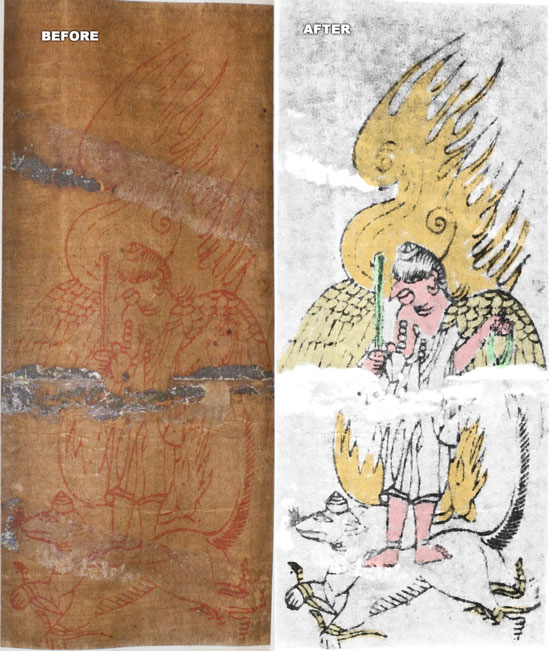mad in pursuit notebook
DISPATCHED FROM THE CROSSROADS
- home >
- favorite themes >
- art & artifacts contents >
- today's entry
Lost in Buddhist Detective Work: Izuna Gongen
This is what happens to me. I set out to make quick work of some inventory activity and I wind up drawn into the mystery.

I photographed every old Buddhist print on a Japanese handscroll. Some are crystal clear and (it turns out) easily identifiable. Others, like the above left, are obscure. What the heck are we looking at? So I wind up on Photoshop, teasing out the image… adding a little color to clarify.
This is still mysterious — not your typical Buddhist diety. Like Fudo Myo-o, his right hand holds a vertically held sword to help him combat the “three poisons”: greed, anger and ignorance; and in his left hand he holds a lasso to catch and bind the evil forces and to prevent them from doing harm; his halo of flames consumes passions. On the other hand, he appears to have a beak and wings, which makes me think bird — so my investigations lead me to Karura (aka Garuda)… but Karura carries a flute, not a sword. And the dog with snakes wrapped around his ankles? The mystery continues…
Revision 7/17/11. Further research reveals this to be Izuna Gongen.
This Japanese aspect, mainly worshipped by the priest of the Shinto Buddhis sanctuaries on Mount Izuna in Shinano Province, has no particular name: it is simply the gongen of Mount Izuna. People often confuse this wrathful form (emanation of Shakyamuni) with Zao Gongen or... Fudo Myo-o. It is often represented with a bird's head, surrounded by flames, standing on a white fox, holding in the right hand a sword with a handle which terminated in a three-pointed vajra... and in the left hand a rope terminating in a hook in the form of a dragon's head... to catch and bind the evil ones and thus prevent them from harming the faithful who invoke it. According to a tradition, this 'force' was perceived for the first time at the temple of Hachio-ji, on Mount Takao, by the monk Gyoki (670-749), who began to desseminate the syncretic doctrines of Ryobu-shinto, derived from the esoterism of the Shingon sect. [Louis Frederic, "Buddhism: Flammarion Iconographic Guides," 1995, p 96]
May 18,2011

